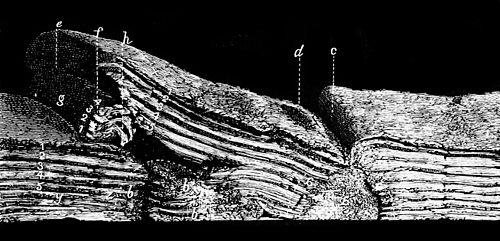the influence of the caoutchouc alone, without the presence of the supports, there are formed only slight wrinkles on the surface of a sheet of clay 3 or 4 cm. in thickness; and if the supports alone compressed the clay placed on a material which is not compressed (a very smooth oiled plate), the clay scarcely wrinkles near the center of its surface; it increases a little in thickness and forms swellings (bourrelets) against the supports. The strata which appear to divide the masses of clay, and which are represented in the figures, are not really strata, but simply horizontal lines at the surface of the clay."
Such pressure as has been applied in these experiments produces contortions of strata which elevate the surface of the matter compressed, as well in the plane parts or plains, as in those which take the forms of valleys, hills, or mountains. These latter have the appearance of vaults or folds, sometimes perpendicular, sometimes warped (déjetés); the ridges are complete, or broken at the summit by a longitudinal fracture, narrow below and wide above; next, another fracture, narrow above and wide below, is produced at the base of the mountain or vault. The sides of valleys are sometimes almost vertical, sometimes present gentle slopes. The strata are less strongly contorted in the lower parts than in the neighborhood of the upper surface. They are disjoined in certain parts by fissures or caverns; they are traversed by clefts or faults inclined or vertical. All these deformations

Fig. 4.
are the more varied in that they are not similar on the opposite sides of the same band of clay.
Most of these phenomena are seen in Fig. 1, which represents the result of an experiment made on a band of clay whose thickness before compression was about 25 mm., while after that it attained 62 mm. at the culminating point. At a is seen a vault a little broken at the summit, covering a cavern similar to that figured in the memoir of Sir J. Hall
